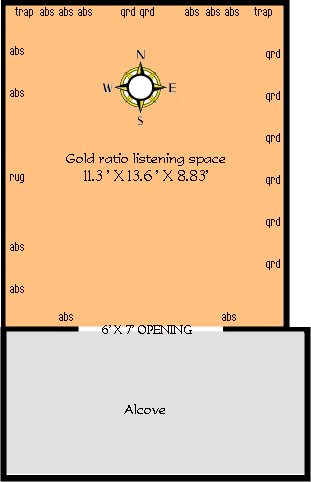My listening
room ~ Steve Deckert
 Layout
Layout
This room
layout was inspired by a listening setup I had at home that features
two adjoining rooms coupled together through a large opening. Flanking
the opening with speakers always yielded spectacular imaging properties.
The opening behind the speakers becomes the perfect absorber/diffuser.
Delays created by the other room add a richness. The
depth of the resulting sound stage is enjoyable as it sounds like
there are actually musicians playing in the second room. Over
the years I've experimented with this and found a small alcove only
6 feet deep can accomplish a great deal. In this room the
alcove ended up around 8 feet.
The room itself, being rather small, inspired me to try something a little different with the treatments. Since no two parallel surfaces should be the same in an ideal listening room I decided to make the East wall hard and the West wall soft. The North and South walls are a combination of both. On the East wall I installed quadratic theory diffusers into the entire wall.
Normally we would wrap a room with carefully placed diffusers in a symmetrical pattern at the reflection points of the speakers. I decided that sound is so fast that it's literally on all four walls simultaneously as far as we perceive it - so placing 100% of the diffusion all on one wall should be no different than 50 % of the diffusion on one wall and 50% on the other. This should be true at least from the over all frequency response of the room itself - my primary concern. This proved to be true because the sound stage does not skew towards one side over the other as I thought it might even though one speakers first reflection point is diffused and one is absorbed.
A few other key factors, the West wall is block with studs and drywall with no insulation. The dead air space creates a wonderful absorber in the mid bass frequencies. The North corners of the room have large CWAL linear diaphragmatic absorbers that cover a couple octaves from around 25Hz up. These are glued to the walls to increase the mass of the walls and help drain wall resonance's. The diffusers on the East wall have integrated diaphragmatic absorbers that start working at 60Hz and up. These diffusers are built-in to become flush with the wall surface. They are also glued to a structural wall that lies behind them. The North wall also has two diffusers glued to it. The total mass that was integrated (glued) to the walls is over 2100 lbs. This ensures that these walls are dead by lowering their resonant frequency from between 200~800 cycles to below 30 cycles.
On the North wall setting on top of the SWAL diffusers are my new prime 13 quadratic diffusers oriented horizontally so as to diffuse vertically. The result of these is a greater sense of height in the sound stage. The ceiling has been treated with bubble wrap. I found this targets a specific "zing" that occurs on the ceiling. This treatment is like leaving the ceiling hard but also diffused from the sphere shaped bubbles. Killer treatment, and affordable.
The frequency response in this room is flatter than any room I've heard to date. The bass response is quite good for it's small size due in part to the alcove increasing the area for low frequencies and it's effect on the axle modes of the listening space. In this room, detail can be heard that is normally never revealed. The effort was clearly worth it!
As you can see from the 360 view of the room I have speakers at both ends. The Acoustats are at the North end, my corner horns, Radials or any of the many other speakers I have are usually listened to on the South end flanking the opening. Which end sounds better depends on what speakers are there, although the South end always has a deeper sound stage. That end of the room is really optimised for my corner horns and with them can paint a mind blowing sound stage . I listen to the Zen amps on this end of the room almost regardless of what speakers I use.
Additional information about this room, it's dimensions and what it was like before can be found here. Also several room related articles can be found in the articles section of the site. You may read the one done in May of 1998 titled "My listening room" and wonder how it compares to this room. (It doesn't)
More information about room treatment can be found here.